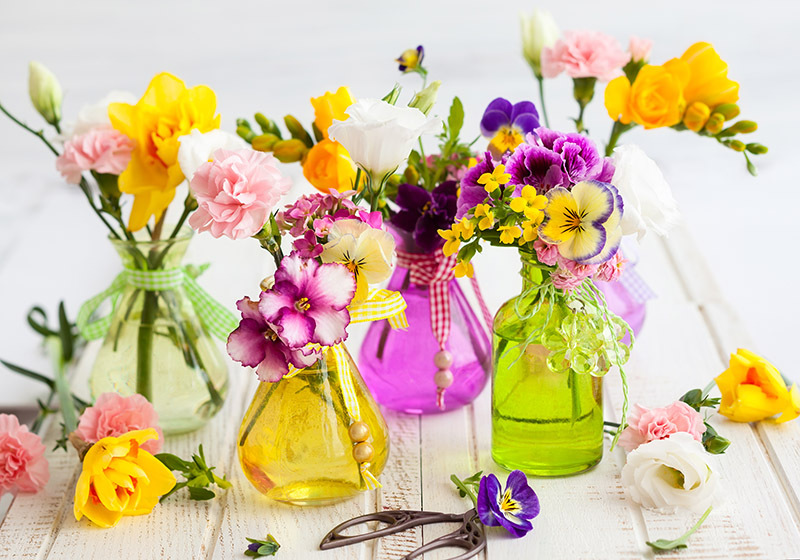Discover Your Birth Flower and Uncover Its Hidden Meaning
Posted on 03/09/2025
Discover Your Birth Flower and Uncover Its Hidden Meaning
Ever wondered if there's more to your birthday than just your zodiac sign or birthstone? Birth flowers are a delightful way to add personal meaning to your special month. Each month of the year has a unique birth flower, symbolizing traits and characteristics that may resonate with you. In this comprehensive guide, you'll not only discover your birth flower, but also uncover the hidden meanings, historical origins, and traditions attached to these beautiful blooms.

What Are Birth Flowers?
Just as each month has a corresponding gemstone, it also has a birth flower. This tradition is believed to date back to ancient Rome, when flowers were often given as birthday gifts and each blossom had a special significance. Over time, cultures around the world embraced the tradition and attributed symbolic meanings to different flowers based on myths, poetry, and folklore.
Today, discovering your birth month flower not only reveals something new about yourself, but can also make your birthday, celebrations, or gifts even more meaningful.
Birth Flowers by Month: Find Your Unique Bloom
Below, you'll find an in-depth breakdown of each month's birth flower, its vibrant symbolism, and a few fascinating facts to enrich your floral knowledge.
January: Carnation
- Color Range: Pink, red, white, yellow, and purple
- Symbolism: Love, fascination, distinction
- Hidden Meaning: Admiration, deep bonds of affection, and good luck
The carnation is renowned for its ruffled petals and subtle fragrance. In ancient times, carnations were used in art and ceremonial crowns, signifying nobility and gratitude. If you were born in January, your birth flower radiates admiration and enduring love.
February: Violet
- Color Range: Purple, blue, white, and yellow
- Symbolism: Modesty, faithfulness, and humility
- Hidden Meaning: Everlasting love and truth
Small but powerful, the violet often symbolizes spiritual wisdom and modesty. Ancient Greeks believed violets could bring luck and vital energy, making this birth flower ideal for free-spirited February-born individuals.
March: Daffodil
- Color Range: Sunny yellow, white, orange
- Symbolism: New beginnings, hope, and rebirth
- Hidden Meaning: Joy, creativity, and energy
The daffodil is closely associated with spring's arrival. Its cheerful bloom brings hope and renewal, symbolizing the optimistic and energetic spirit of March birthdays.
April: Daisy
- Color Range: White petals with yellow centers (many variations exist!)
- Symbolism: Innocence, purity, and new beginnings
- Hidden Meaning: True love and loyalty
A timeless symbol of innocence, the daisy has enchanted poets and artists for centuries. If April is your month, this birth flower represents your fresh outlook and genuine nature.
May: Lily of the Valley
- Color Range: Delicate white, sometimes pink
- Symbolism: Sweetness, humility, and return to happiness
- Hidden Meaning: Purity of heart and the promise of happiness
The gentle lily of the valley embodies sweetness and humility. In folklore, it is seen as a symbol of hope and renewal--a perfect bloom to represent those born in May.
June: Rose
- Color Range: Red, pink, yellow, white, and more
- Symbolism: Love, beauty, respect
- Hidden Meaning: Deep passion, friendship, and new beginnings (depending on color)
Arguably the world's most iconic flower, the rose is the epitome of love and elegance. Different colors carry various meanings, making this birth flower incredibly versatile and meaningful for June-born romantics and dreamers.
July: Larkspur
- Color Range: Blue, purple, white, and pink
- Symbolism: Positivity, grace, and dignity
- Hidden Meaning: Lightness of heart and open mind
With its tall, spiky blossoms, larkspur adds a sense of playfulness to gardens and bouquets. July's birth flower reflects the open-hearted, charming nature of summer babies.
August: Gladiolus
- Color Range: Pink, red, white, yellow, salmon, purple
- Symbolism: Strength, integrity, infatuation
- Hidden Meaning: Moral character and determination
The striking gladiolus is named after the Latin word for "sword," referencing its pointed leaves. August-born individuals often embrace this flower's association with courage and ambition.
September: Aster
- Color Range: Purple, pink, white, blue, red
- Symbolism: Wisdom, faith, valor
- Hidden Meaning: Elegance and powerful love
The aster was esteemed by ancient civilizations for its supposed magical properties. With its star-like shape (the name "Aster" means "star" in Greek), this birth flower is perfect for September's bright and thoughtful personalities.
October: Marigold
- Color Range: Gold, orange, yellow, red
- Symbolism: Warmth, creativity, and passion
- Hidden Meaning: Fierce loyalty and determination
Bold and vibrant, the marigold has deep roots in celebrations and rituals worldwide. October's birth flower shines a spotlight on creative spirits and the warmth they bring to others.
November: Chrysanthemum
- Color Range: Red, yellow, white, purple, pink
- Symbolism: Friendship, happiness, and well-being
- Hidden Meaning: Loyalty and honesty
The chrysanthemum, with its wide array of rich colors, has been celebrated for centuries in Asian cultures as a symbol of immortality and joy. November birthdays can embrace the enduring happiness and trust this bloom represents.
December: Narcissus (Paperwhite)
- Color Range: White, light yellow, orange
- Symbolism: Self-esteem, rebirth, and hope
- Hidden Meaning: Renewal and faithfulness
The narcissus, or paperwhite, stands for optimism and sincere affection. December-born individuals can find inspiration in this birth flower's message of renewal and cheerful energy, making the end of the year bright and uplifting.
The Historical Significance of Birth Flowers
The tradition of associating flowers with specific months and birthdays has varied roots, drawing from Roman, Greek, Victorian, and other cultural influences.
- Romans used flowers in celebrations and believed specific flowers brought good fortune to the birthday person.
- Victorian Era popularized the "language of flowers," or floriography, giving each flower intricate meanings through color and type.
- In Eastern cultures, such as those in China and Japan, flowers were symbolic in poems, art, and folklore, each carrying messages of virtue and good luck.
Today, birth month flowers are used for bouquets, jewelry, tattoos, and other gifting traditions, making them a meaningful way to celebrate one's identity and heritage.
How to Use Your Birth Flower in Every Day Life
Knowing your birth flower and its meaning opens up new possibilities for personal expression and self-discovery. Here are several ways you can incorporate your birthday blossom into your routine:
- Gift-giving: Choose a bouquet featuring someone's birth month flower for birthdays, anniversaries, or 'just because' moments.
- Home Decor: Add fresh or dried birth month flowers to interiors for a touch of symbolism and beauty.
- Jewelry and Accessories: Seek out pieces adorned with your birth flower's shape or motif.
- Personal Development: Reflect on the traits and meanings behind your birth flower -- do you see these qualities in yourself?
- Tattoos: A birth flower tattoo can be a permanent reminder of your personal symbolism.

Interesting Facts and FAQs About Birth Flowers
Q: Are birth flowers the same in every country?
A: While the commonly accepted list matches what you'll find above, some countries have different flowers associated with each month due to local species or traditions. Always check regional lists for added layers of meaning!
Q: Can I have more than one birth flower?
A: Some months have multiple associated flowers. For example, April is sometimes linked to the sweet pea, and December may feature holly in addition to narcissus. Enjoy the flexibility and choose the bloom that resonates most with you.
Q: Do birth flowers really reveal personality traits?
A: Like zodiac signs and other birth symbols, birth flowers are best enjoyed for their inspiration and tradition. While they may not predict your personality, the symbolic meanings can offer fun insights and new ways to celebrate who you are.
Q: How were the meanings of each birth flower decided?
A: Meanings stem from centuries-old traditions, religious symbolism, myths, and sometimes the natural behavior of the plant (such as when it blooms or its medicinal uses).
Final Thoughts: Embrace Your Birth Flower's Hidden Meaning
Whether you're a passionate rose of June or a wise aster of September, discovering your birth flower and uncovering its hidden meaning can be a beautiful journey of self-knowledge. These floral symbols connect us to history, culture, and the natural world, offering a unique lens through which to see ourselves and those we love.
Next time you celebrate a special date, consider the power of your birth flower. Let its color, beauty, and meaning inspire you or someone you care about. Not only are these blooms a gift from nature, but also a reminder that every month, every person, comes with a story worth sharing.
Explore the world of birth flowers, and let your special bloom brighten each day!
Latest Posts
Discover Your Birth Flower and Uncover Its Hidden Meaning
The Tradition Behind Giving Red Roses on Valentine's Day
7 Surprising Facts About Tulips You May Not Know
Top Picks: Birthday Blooms to Brighten Their Day
Discover 3 Simple Methods to Keep Your Flowers Fresh and Vibrant






